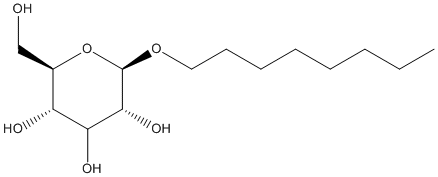Octylglucoside
General
Type : Analogue of substrate || Detergent || Surfactant || Carbohydrate || Glycoside
Chemical_Nomenclature : (2R,3S,4S,5R,6R)-2-(hydroxymethyl)-6-octoxyoxane-3,4,5-triol
Canonical SMILES : CCCCCCCCOC1C(C(C(C(O1)CO)O)O)O
InChI : InChI=1S\/C14H28O6\/c1-2-3-4-5-6-7-8-19-14-13(18)12(17)11(16)10(9-15)20-14\/h10-18H,2-9H2,1H3\/t10-,11-,12+,13-,14-\/m1\/s1
InChIKey : HEGSGKPQLMEBJL-RKQHYHRCSA-N
Other name(s) : OG, BOG, Octyl-beta-D-glucopyranoside, B-Octylglucoside, Octyl beta-D-glucopyranoside, Octyl beta-D-glucoside, Octyl glucoside

Target
Families : ACPH_Peptidase_S9, Canar_LipB, ABHD6-Lip, Acidic_Lipase
References (7)
| Title : Structural, mechanistic and physiological insights into phospholipase A-mediated membrane phospholipid degradation in Pseudomonas aeruginosa - Bleffert_2022_Elife_11_e72824 |
| Author(s) : Bleffert F , Granzin J , Caliskan M , Schott-Verdugo SN , Siebers M , Thiele B , Rahme LG , Felgner S , Dormann P , Gohlke H , Batra-Safferling R , Erich-Jager K , Kovacic F |
| Ref : Elife , 11 : , 2022 |
| Abstract : Bleffert_2022_Elife_11_e72824 |
| ESTHER : Bleffert_2022_Elife_11_e72824 |
| PubMedSearch : Bleffert_2022_Elife_11_e72824 |
| PubMedID: 35536643 |
| Gene_locus related to this paper: pseae-PA2949 |
| Title : Evidence for a bacterial Lands cycle phospholipase A: Structural and mechanistic insights into membrane phospholipid remodeling - Bleffert_2021_Biorxiv__ |
| Author(s) : Bleffert F , Granzin J , Caliskan M , Schott-Verdugo SN , Siebers M , Thiele B , Rahme L , Felgner S , Dormann P , Gohlke H , Batra-Safferling R , Jaeger KE , Kovacic F |
| Ref : Biorxiv , : , 2021 |
| Abstract : Bleffert_2021_Biorxiv__ |
| ESTHER : Bleffert_2021_Biorxiv__ |
| PubMedSearch : Bleffert_2021_Biorxiv__ |
| PubMedID: |
| Gene_locus related to this paper: pseae-PA2949 |
| Title : Pseudomonas aeruginosa esterase PA2949, a bacterial homolog of the human membrane esterase ABHD6: expression, purification and crystallization - Bleffert_2019_Acta.Crystallogr.F.Struct.Biol.Commun_75_270 |
| Author(s) : Bleffert F , Granzin J , Gohlke H , Batra-Safferling R , Jaeger KE , Kovacic F |
| Ref : Acta Crystallographica F Struct Biol Commun , 75 :270 , 2019 |
| Abstract : Bleffert_2019_Acta.Crystallogr.F.Struct.Biol.Commun_75_270 |
| ESTHER : Bleffert_2019_Acta.Crystallogr.F.Struct.Biol.Commun_75_270 |
| PubMedSearch : Bleffert_2019_Acta.Crystallogr.F.Struct.Biol.Commun_75_270 |
| PubMedID: 30950828 |
| Gene_locus related to this paper: pseae-PA2949 |
| Title : Effects of surfactants on lipase structure, activity, and inhibition - Delorme_2011_Pharm.Res_28_1831 |
| Author(s) : Delorme V , Dhouib R , Canaan S , Fotiadu F , Carriere F , Cavalier JF |
| Ref : Pharm Res , 28 :1831 , 2011 |
| Abstract : Delorme_2011_Pharm.Res_28_1831 |
| ESTHER : Delorme_2011_Pharm.Res_28_1831 |
| PubMedSearch : Delorme_2011_Pharm.Res_28_1831 |
| PubMedID: 21234659 |
| Title : Crystal Structure of an Acylpeptide Hydrolase\/Esterase from Aeropyrum pernix K1. - Bartlam_2004_Structure.(Camb)_12_1481 |
| Author(s) : Bartlam M , Wang G , Yang H , Gao R , Zhao X , Xie G , Cao S , Feng Y , Rao Z |
| Ref : Structure(Camb) , 12 :1481 , 2004 |
| Abstract : Bartlam_2004_Structure.(Camb)_12_1481 |
| ESTHER : Bartlam_2004_Structure.(Camb)_12_1481 |
| PubMedSearch : Bartlam_2004_Structure.(Camb)_12_1481 |
| PubMedID: 15296741 |
| Gene_locus related to this paper: aerpe-APE1547 |
| Title : Crystal structure of the open form of dog gastric lipase in complex with a phosphonate inhibitor - Roussel_2002_J.Biol.Chem_277_2266 |
| Author(s) : Roussel A , Miled N , Berti-Dupuis L , Riviere M , Spinelli S , Berna P , Gruber V , Verger R , Cambillau C |
| Ref : Journal of Biological Chemistry , 277 :2266 , 2002 |
| Abstract : Roussel_2002_J.Biol.Chem_277_2266 |
| ESTHER : Roussel_2002_J.Biol.Chem_277_2266 |
| PubMedSearch : Roussel_2002_J.Biol.Chem_277_2266 |
| PubMedID: 11689574 |
| Gene_locus related to this paper: canfa-1lipg |
| Title : The sequence, crystal structure determination and refinement of two crystal forms of lipase B from Candida antarctica - Uppenberg_1994_Structure_2_293 |
| Author(s) : Uppenberg J , Hansen MT , Patkar S , Jones TA |
| Ref : Structure , 2 :293 , 1994 |
| Abstract : Uppenberg_1994_Structure_2_293 |
| ESTHER : Uppenberg_1994_Structure_2_293 |
| PubMedSearch : Uppenberg_1994_Structure_2_293 |
| PubMedID: 8087556 |
| Gene_locus related to this paper: canar-LipB |